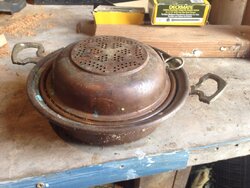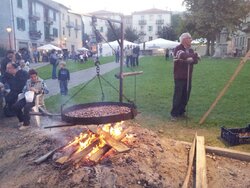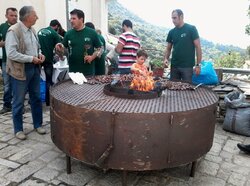What is this?
- Thread starter mgodzilla2
- Start date
-
Active since 1995, Hearth.com is THE place on the internet for free information and advice about wood stoves, pellet stoves and other energy saving equipment.
We strive to provide opinions, articles, discussions and history related to Hearth Products and in a more general sense, energy issues.
We promote the EFFICIENT, RESPONSIBLE, CLEAN and SAFE use of all fuels, whether renewable or fossil.
You are using an out of date browser. It may not display this or other websites correctly.
You should upgrade or use an alternative browser.
You should upgrade or use an alternative browser.
- Status
- Not open for further replies.
deere317
New Member
I forgot to add that the bottom has bump outs to offset it up a bit from the bottom so it seems wood stove oriented since it would wobble on a burner. .
Yep it could steam but it would does not hold too much water. A hot stove would evap the water pretty fast.
Yep it could steam but it would does not hold too much water. A hot stove would evap the water pretty fast.
deere317
New Member
Hmmm so you mean to evaporate water to add moisture to the room? I would expect it to be full of scale and more tarnished from minerals. Its pretty clean.
Holds maybe a liter or quart.How much water do you think it holds
Hogwildz
Minister of Fire
john11756
Member
Simonkenton
Minister of Fire
It is a chestnut roaster. These were very commonplace a hundred years ago, when there were lots of chestnut trees. I have a chestnut roaster and roast chestnuts in my fireplace, but you could roast them atop a wood stove. The holes are in the top because chestnuts give off steam as they roast.
You can find lots of chestnut roasters on ebay, they can go for $35 to $140. If you could get yours checked by an expert it might be a valuable find. Lots of the really nice roasters, which yours looks to be one, were made in England 140 or more years ago.
You can find lots of chestnut roasters on ebay, they can go for $35 to $140. If you could get yours checked by an expert it might be a valuable find. Lots of the really nice roasters, which yours looks to be one, were made in England 140 or more years ago.
I don't remember Grandma ever using it for that but could be. I was 12 so...... I think my sister uses it for a planter.It is a chestnut roaster. These were very commonplace a hundred years ago, when there were lots of chestnut trees. I have a chestnut roaster and roast chestnuts in my fireplace, but you could roast them atop a wood stove. The holes are in the top because chestnuts give off steam as they roast.
You can find lots of chestnut roasters on ebay, they can go for $35 to $140. If you could get yours checked by an expert it might be a valuable find. Lots of the really nice roasters, which yours looks to be one, were made in England 140 or more years ago.
mark cline
Minister of Fire
Simonkenton
Minister of Fire
In 1900 the chestnut tree was one of the most prominent, and valuable trees in the eastern United States. In the Fall, chestnuts lay on the ground six inches thick beneath the chestnut trees. Farmers would turn their hogs loose in September and let them gorge themselves on wild chestnuts.
People liked chestnuts too, like in The Christmas Song "Chestnuts roasting on an open fire..." Chestnuts were a major food source from Georgia to Maine, from Ohio to Tennessee.
Chestnut wood was highly prized, and was used in log cabin construction, and for furniture.
In 1904 a New York Yankee imported some diseased Asian chestnut trees and planted them in Central Park. They contained the Chestnut Blight. Within 30 years, the chestnut tree was obliterated from the forests of the Eastern United States. Chestnut trees had been about 25 percent of the trees in the eastern forests.
This was the greatest ecological disaster in the US in the past 10,000 years.
So that, when you were 12, the chestnut tree would have been long gone. Michigan was on the periphery of the chestnut range, but they surely would have been imported to Michigan.
Your grandmother wouldn't have known about them, but I bet your great grandmother did.
People liked chestnuts too, like in The Christmas Song "Chestnuts roasting on an open fire..." Chestnuts were a major food source from Georgia to Maine, from Ohio to Tennessee.
Chestnut wood was highly prized, and was used in log cabin construction, and for furniture.
In 1904 a New York Yankee imported some diseased Asian chestnut trees and planted them in Central Park. They contained the Chestnut Blight. Within 30 years, the chestnut tree was obliterated from the forests of the Eastern United States. Chestnut trees had been about 25 percent of the trees in the eastern forests.
This was the greatest ecological disaster in the US in the past 10,000 years.
So that, when you were 12, the chestnut tree would have been long gone. Michigan was on the periphery of the chestnut range, but they surely would have been imported to Michigan.
Your grandmother wouldn't have known about them, but I bet your great grandmother did.
Last edited:
I was at a chestnut festival in rural Italy a few years ago and they had a pan that was 3' across and was hung with a chain.
My guess is that it was used to store hot coals to take to the neighbors to start a fire with - but who knows - I only go back to horse and buggies, not prior.
My guess is that it was used to store hot coals to take to the neighbors to start a fire with - but who knows - I only go back to horse and buggies, not prior.

Attachments
Simonkenton
Minister of Fire

Here is an antique English chestnut roaster I just looked up on Ebay, going for $99. Also can be used for popcorn popping. Pan diameter is 9 inches. You see these, from 6 inch to about 15 inch diameter. Lots and lots of these on Ebay.
Most of these have a long handle, for roasting on an open fire, but with no handle it would be designed for a wood stove.
This one is made of copper, you also see them made of brass and bronze. If you would inspect your roaster, you might find the place of manufacture. Yours looks to be a nice, high quality roaster.
Interesting Simon! A story I had heard is that Wormy Chestnut in particular was used almost exclusively for the building of barns in my area because there was little drying time involved. Farmers could literally mill it and build with it immediately.
I was told in the late 90's that farmers were cashing in from tearing there wormy chestnut barns down. Selling the sought after wood, and rebuilding them.
I was told in the late 90's that farmers were cashing in from tearing there wormy chestnut barns down. Selling the sought after wood, and rebuilding them.
Stella
Burning Hunk
firefighterjake
Minister of Fire
In 1900 the chestnut tree was one of the most prominent, and valuable trees in the eastern United States. In the Fall, chestnuts lay on the ground six inches thick beneath the chestnut trees. Farmers would turn their hogs loose in September and let them gorge themselves on wild chestnuts.
People liked chestnuts too, like in The Christmas Song "Chestnuts roasting on an open fire..." Chestnuts were a major food source from Georgia to Maine, from Ohio to Tennessee.
Chestnut wood was highly prized, and was used in log cabin construction, and for furniture.
In 1904 a New York Yankee imported some diseased Asian chestnut trees and planted them in Central Park. They contained the Chestnut Blight. Within 30 years, the chestnut tree was obliterated from the forests of the Eastern United States. Chestnut trees had been about 25 percent of the trees in the eastern forests.
This was the greatest ecological disaster in the US in the past 10,000 years.
So that, when you were 12, the chestnut tree would have been long gone. Michigan was on the periphery of the chestnut range, but they surely would have been imported to Michigan.
Your grandmother wouldn't have known about them, but I bet your great grandmother did.
So is that a baseball player with the New York Yankees imported the blighted trees . . . or a New York resident imported the tree?

Simonkenton
Minister of Fire
Great pic, Stella! Now, that is chestnuts roasting on an open fire!
You are from the Peloponnese? Are you from Sparta?
In 1973 I travelled all over Europe. In Germany, in Denmark, and in other countries, on every street corner of a big town there would be a guy selling roasted chestnuts.
He would have a little cart with a charcoal fire. He would put a dozen roasted chestnuts in a cone made of newspaper and sell them for a buck or so. I had never seen a chestnut before, but "When in Rome..." Chestnuts became a major part of my diet on that trip and they were really delicious.
As I now live in the heart of the former range of the chestnuts, in the mountains of North Carolina, my brother and I are re introducing the chestnut tree. There is a type of chestnut tree called the Dunstan Chestnut and it is blight-proof. I have planted 6 of these trees and my brother has planted 30 of them. In a few years, a squirrel grabs a nut that has fallen off of one of our trees, runs a hundred feet and buries it, a crow grabs a nut, flies across the river and drops it, in a few decades we will have reinstituted the Chestnut tree in Madison County North Carolina.
You are from the Peloponnese? Are you from Sparta?
In 1973 I travelled all over Europe. In Germany, in Denmark, and in other countries, on every street corner of a big town there would be a guy selling roasted chestnuts.
He would have a little cart with a charcoal fire. He would put a dozen roasted chestnuts in a cone made of newspaper and sell them for a buck or so. I had never seen a chestnut before, but "When in Rome..." Chestnuts became a major part of my diet on that trip and they were really delicious.
As I now live in the heart of the former range of the chestnuts, in the mountains of North Carolina, my brother and I are re introducing the chestnut tree. There is a type of chestnut tree called the Dunstan Chestnut and it is blight-proof. I have planted 6 of these trees and my brother has planted 30 of them. In a few years, a squirrel grabs a nut that has fallen off of one of our trees, runs a hundred feet and buries it, a crow grabs a nut, flies across the river and drops it, in a few decades we will have reinstituted the Chestnut tree in Madison County North Carolina.
Stella
Burning Hunk
Great pic, Stella! Now, that is chestnuts roasting on an open fire!
You are from the Peloponnese? Are you from Sparta?
Actually no, Sparta is a little bit away from us and up in the mountains, actually think the road to there might be blocked by snow at the moment. Our house is on the coast which is slightly warmer, thank goodness, although this evening it feels as if it is beginning to freeze. These last two days have been the coldest I have known here although certainly in the north of Greece people are really suffering with subzero temps, no money and no heating. I know people here who cannot afford any heat, miserable at this time of year and a killer for those who are elderly, young or have compromised immune systems.Great pic, Stella! Now, that is chestnuts roasting on an open fire!
You are from the Peloponnese? Are you from Sparta?
In 1973 I travelled all over Europe. In Germany, in Denmark, and in other countries, on every street corner of a big town there would be a guy selling roasted chestnuts.
He would have a little cart with a charcoal fire. He would put a dozen roasted chestnuts in a cone made of newspaper and sell them for a buck or so. I had never seen a chestnut before, but "When in Rome..." Chestnuts became a major part of my diet on that trip and they were really delicious.
As I now live in the heart of the former range of the chestnuts, in the mountains of North Carolina, my brother and I are re introducing the chestnut tree. There is a type of chestnut tree called the Dunstan Chestnut and it is blight-proof. I have planted 6 of these trees and my brother has planted 30 of them. In a few years, a squirrel grabs a nut that has fallen off of one of our trees, runs a hundred feet and buries it, a crow grabs a nut, flies across the river and drops it, in a few decades we will have reinstituted the Chestnut tree in Madison County North Carolina.
Ram 1500 with an axe...
Minister of Fire
OK, your chestnut roaster is bigger than mine. But do they make beer with the chestnuts? When I was at the bar in Tuscany during chestnut harvest, the bartender offered me a chestnut beer. Little bit of an odd taste but I'm game to try most stuff. Whoops, 10 Euros a bottle. Brought the bottle home as a souvenir.
Chestnut wood was highly prized, and was used in log cabin construction, and for furniture.
My wife grew up in an inn made of chestnut logs. Built during the depression from cheap and ubiquitous dead chestnut it was a beautiful home to live in. Still is, but it's no longer an inn.
- Status
- Not open for further replies.
Similar threads
- Replies
- 11
- Views
- 938
- Replies
- 2
- Views
- 536
- Replies
- 3
- Views
- 389




